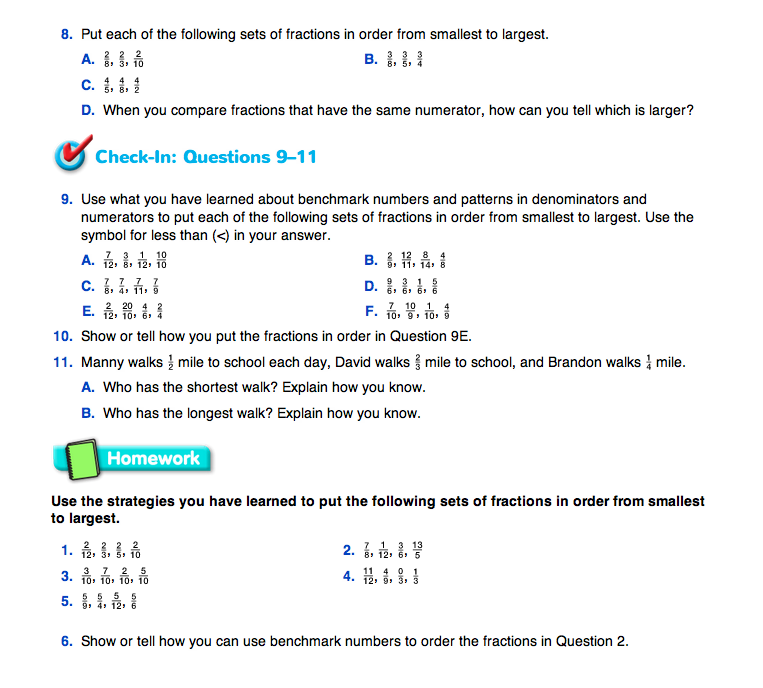Ask students to think about the strategies they can use to help them compare and order fractions.
- How can you use benchmark numbers to help you compare and order fractions? (Possible response: Look at the numerator and denominator to see if the fraction is closer to zero, to 1/2, or to 1.)
- If you have the fraction 8/9 , how will the numerator and denominator help you decide if the fraction is closer to 0, 1/2, or 1? (Possible response: Since the numerator and denominator are very close to each other, you know that this fraction will be close to 1 because 9/9 = 1 and 8/9 is just a little bit less.)
- If you have the fraction 3/10 , how can you use benchmark numbers to decide if the fraction is less than or greater than 1/2? (Possible response: Since 5 is half of 10 you know that 5/10 = 1/2. Since 3/10 is less than 5/10 , it is also less than 1/2.)
- If you are comparing fractions with common denominators, how will the numerator help you decide how to order the fractions from smallest to largest? (Possible response: If all the fractions have the same denominator, then you put them in order from the smallest numerator to the largest numerator.)
- How can you use the denominator to order fractions from smallest to largest if they all have the same numerator? (Possible response: The larger the denominator, the smaller the fraction will be since the whole is divided into more pieces. If all the fractions have the same numerator, you would put them in order with the largest denominator first and the smallest denominator last.)
After reviewing the different strategies, students complete Check-In: Questions 9–11 on the Compare Fractions to Benchmarks pages in the Student Guide. Before students begin their work, display the Math Practices page from the Student Guide Reference section. Tell students that they should focus on Math Practices Expectations 1 and 5 as they solve Question 11A–B.
- What do you need to do to make sure you are solving this problem carefully and accurately? (Possible response: Make sure you read the problem carefully and know what questions you are being asked to answer. Make sure you answer all of the questions being asked.)
- What should you include in your explanation so someone else can understand your thinking? (Possible response: Include the tools and strategies you used to decide your answer. Use words or pictures to help someone understand your thinking. Label your answers carefully so they match the questions being asked.)
Ask students to complete Check-In: Questions 9–11 independently.
Use Check-In: Questions 9–11 in the Compare Fractions to Benchmarks pages of the Student Guide to assess students' abilities to compare and order fractions [E6], know the problem [MPE1], and show work [MPE5].
Assign the Comparing Fractions Quiz Assessment Master to assess students' abilities to compare fractions.
Use the Comparing Fractions Quiz Assessment Master with Feedback Box to assess students' progress toward comparing fractions [E6], identifying equivalent fractions [E4], finding a strategy [MPE2], and showing work [MPE5].













